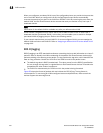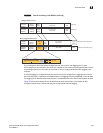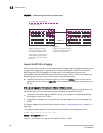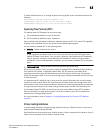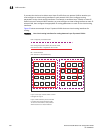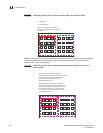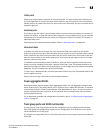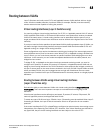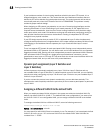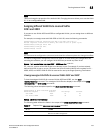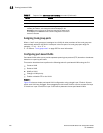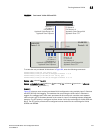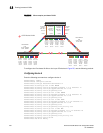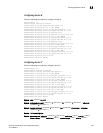
442 PowerConnect B-Series FCX Configuration Guide
53-1002266-01
VLAN overview
13
Summary of VLAN configuration rules
A hierarchy of VLANs exists between the Layer 2 and Layer 3 protocol-based VLANs:
• Port-based VLANs are at the lowest level of the hierarchy.
• Layer 3 protocol-based VLANs, IP, IPv6, IPX, AppleTalk, Decnet, and NetBIOS are at the middle
level of the hierarchy.
• IP subnet, IPX network, and AppleTalk cable VLANs are at the top of the hierarchy.
NOTE
You cannot have a protocol-based VLAN and a subnet or network VLAN of the same protocol type in
the same port-based VLAN. For example, you can have an IPX protocol VLAN and IP subnet VLAN in
the same port-based VLAN, but you cannot have an IP protocol VLAN and an IP subnet VLAN in the
same port-based VLAN, nor can you have an IPX protocol VLAN and an IPX network VLAN in the same
port-based VLAN.
As a Dell PowerConnect device receives packets, the VLAN classification starts from the highest
level VLAN first. Therefore, if an interface is configured as a member of both a port-based VLAN and
an IP protocol VLAN, IP packets coming into the interface are classified as members of the IP
protocol VLAN because that VLAN is higher in the VLAN hierarchy.
Multiple VLAN membership rules
• A port can belong to multiple, unique, overlapping Layer 3 protocol-based VLANs without VLAN
tagging.
• A port can belong to multiple, overlapping Layer 2 port-based VLANs only if the port is a tagged
port. Packets sent out of a tagged port use an 802.1Q-tagged frame.
• When both port and protocol-based VLANs are configured on a given device, all protocol VLANs
must be strictly contained within a port-based VLAN. A protocol VLAN cannot include ports from
multiple port-based VLANs. This rule is required to ensure that port-based VLANs remain
loop-free Layer 2 broadcast domains.
• IP protocol VLANs and IP subnet VLANs cannot operate concurrently on the system or within
the same port-based VLAN.
• IPX protocol VLANs and IPX network VLANs cannot operate concurrently on the system or
within the same port-based VLAN.
• If you first configure IP and IPX protocol VLANs before deciding to partition the network by IP
subnet and IPX network VLANs, then you need to delete those VLANs before creating the IP
subnet and IPX network VLANs.
• One of each type of protocol VLAN is configurable within each port-based VLAN on the Layer 2
Switch.
• Multiple IP subnet and IPX network VLANs are configurable within each port-based VLAN on
the Layer 2 Switch.
• Removing a configured port-based VLAN from a Layer 2 Switch or Layer 3 Switch automatically
removes any protocol-based VLAN, IP subnet VLAN, AppleTalk cable VLAN, or IPX network
VLAN, or any Virtual Ethernet router interfaces defined within the Port-based VLAN.



